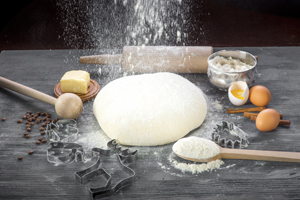 Q Under what circumstances would you advocate xanthan gum in baking and when is it not needed?
Q Under what circumstances would you advocate xanthan gum in baking and when is it not needed?
The gluten found in wheat flour plays an important role in the texture of our familiar baked goods. When absent, as in gluten-free flour, baking results sometimes don’t live up to our expectations. Xanthan gum, when added in small amounts to gluten-free flours, can bind and add stability in gluten-free baking.
A fine white powder, xanthan is a bio-gum produced by the fermentation of sugars with a friendly bacteria called Xanthomonas Campestris. When using xanthan gum, it is best to blend with plain flour before you start baking. Some gluten-free flour blends, such as Doves Farm White Bread Flour Free From Gluten, already contain the perfect quantity of xanthan gum needed to perfect your recipe, so be sure to check the ingredients to see whether or not it is necessary to add in more xanthan.
For example, if it is not already included in your flour blend, mix two teaspoons of gum with 500g (1lb 1oz) plain flour for bread and ¼ tsp to 200g (7oz) flour for cakes. For gluten-free pastry making, it is important to add sufficient liquid to the flour to hydrate the dough properly. Using too much xanthan gum may make your baking a little heavy, so in pastry, only a pinch per 100g (3½oz) flour is required.
 About the expert: Clare Marriage’s love of baking, together with the gluten-free demands within her family, led her to create flour blends as alternatives to gluten containing flours. Clare and Michael Marriage established Doves Farm Foods in 1978. The company is a pioneer of the UK organic and gluten-free sectors and recently has launched an exciting new range of flapjacks and cookies free-from gluten, milk, peanut, egg and soya. www.dovesfarm.co.uk
About the expert: Clare Marriage’s love of baking, together with the gluten-free demands within her family, led her to create flour blends as alternatives to gluten containing flours. Clare and Michael Marriage established Doves Farm Foods in 1978. The company is a pioneer of the UK organic and gluten-free sectors and recently has launched an exciting new range of flapjacks and cookies free-from gluten, milk, peanut, egg and soya. www.dovesfarm.co.uk
